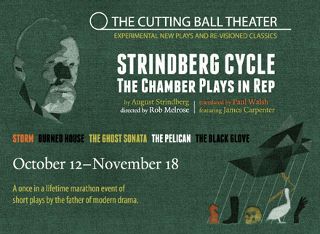AN AUGUST PROJECT
In many ways, playwright August Strindberg’s influence in the theater has been far more significant than his public reception. While theater historians and scholars speak of Strindberg (1849-1912) with the fervency normally associated with Shakespeare, only five of his over sixty plays are produced with any kind of regularity: The Father, Miss Julie, A Dream Play, The Dance of Death, and The Ghost Sonata; these plays are also the best-read and the most anthologized and influential.
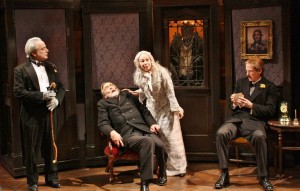 The main reason for the dearth of Strindberg’s produced work is that he did not write for the masses. “That my tragedy depresses many people is their own fault,” he wrote in his foreword to Miss Julie. “My tragedy The Father was recently criticized for being too sad’”as if one wants cheerful tragedies! Everybody is clamoring for this supposed “joy of life,” and theatre managers demand farces, as if the joy of life consisted in being ridiculous and portraying all human beings as suffering from St. Vitus’ dance or total idiocy. I myself find joy of life in its strong and cruel struggles, and my pleasure in learning, in adding to my knowledge.”
The main reason for the dearth of Strindberg’s produced work is that he did not write for the masses. “That my tragedy depresses many people is their own fault,” he wrote in his foreword to Miss Julie. “My tragedy The Father was recently criticized for being too sad’”as if one wants cheerful tragedies! Everybody is clamoring for this supposed “joy of life,” and theatre managers demand farces, as if the joy of life consisted in being ridiculous and portraying all human beings as suffering from St. Vitus’ dance or total idiocy. I myself find joy of life in its strong and cruel struggles, and my pleasure in learning, in adding to my knowledge.”
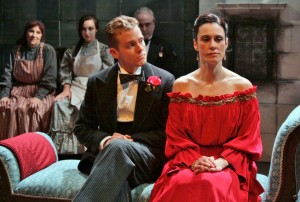 Among his many pioneering theatrical innovations’”expressionism, dream plays’”Strindberg brought “naturalism” to the stage: Utilizing the philosophy of Emile Zola, he used characterization to replace plot as the predominant dramatic element. He wanted theater to be a place for consistently new dramatic art, a place of entertainment for educated people. He wrote, “While waiting for such a theatre, we may as well go on writing so as to stock that particular repertory of the future.” As such, no playwright of his era was bolder, more original, more complex.
Among his many pioneering theatrical innovations’”expressionism, dream plays’”Strindberg brought “naturalism” to the stage: Utilizing the philosophy of Emile Zola, he used characterization to replace plot as the predominant dramatic element. He wanted theater to be a place for consistently new dramatic art, a place of entertainment for educated people. He wrote, “While waiting for such a theatre, we may as well go on writing so as to stock that particular repertory of the future.” As such, no playwright of his era was bolder, more original, more complex.
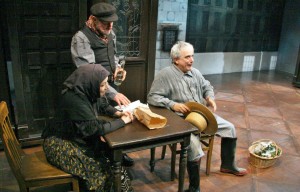 Now, on the centennial of the Swedish playwright’s death, his repertory of the future is here in San Francisco, as Cutting Ball Theater opens its 14th season with Strindberg Cycle, its most ambitious project to date. The cycle is a festival of five of August Strindberg’s Chamber Plays’”The Ghost Sonata, The Pelican, The Black Glove, Storm, and Burned House’”which will be presented in repertory. The plays had staggered openings, but all are running as of today. All five have new translations by Paul Walsh (A.C.T., Yale School of Drama), and they are directed by Cutting Ball Artistic Director Rob Melrose. This will be the first time all five of these Chamber Plays will be performed together in repertory in any language. Audiences will have the opportunity to see the plays performed separately, or in a “Chamber Play Marathon,” which is all five shows in one day. Strindberg Cycle features James Carpenter, Robert Parsons, Caitlyn Louchard, Danielle O’Hare, Carl Holvick-Thomas, David Sinaiko, Ponder Goddard, Paul Gerrior, and Gwyneth Richards, along with Anne Hallinan, Nick Trengove, Michael Moerman, and Alex Shafer.
Now, on the centennial of the Swedish playwright’s death, his repertory of the future is here in San Francisco, as Cutting Ball Theater opens its 14th season with Strindberg Cycle, its most ambitious project to date. The cycle is a festival of five of August Strindberg’s Chamber Plays’”The Ghost Sonata, The Pelican, The Black Glove, Storm, and Burned House’”which will be presented in repertory. The plays had staggered openings, but all are running as of today. All five have new translations by Paul Walsh (A.C.T., Yale School of Drama), and they are directed by Cutting Ball Artistic Director Rob Melrose. This will be the first time all five of these Chamber Plays will be performed together in repertory in any language. Audiences will have the opportunity to see the plays performed separately, or in a “Chamber Play Marathon,” which is all five shows in one day. Strindberg Cycle features James Carpenter, Robert Parsons, Caitlyn Louchard, Danielle O’Hare, Carl Holvick-Thomas, David Sinaiko, Ponder Goddard, Paul Gerrior, and Gwyneth Richards, along with Anne Hallinan, Nick Trengove, Michael Moerman, and Alex Shafer.
For fascinating essays, synopses, character descriptions, and further studies, visit the Cutting Ball web site. The more you know before you attend, the more it will enhance your experience. Cutting Ball has clearly put a lot of time, energy, and love into this project so that you most certainly will have a greater understanding of why many consider Strindberg to be the father of modern drama.
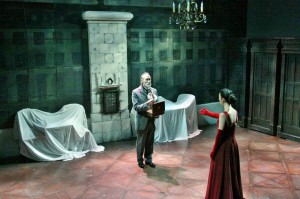 According to Mr. Melrose, who blew me away with his production of The Tempest, “The Chamber Plays encapsulate the themes and techniques Strindberg mastered over his lifetime: ghosts, being haunted by one’s past, the subjectivity of perception, and the thorny relations between men and women. In addition to pioneering theatrical movements in both Realism and Expressionism, Strindberg was a painter, writer, botanist, chemist, photographer, and a linguist. Strindberg was like the Leonardo da Vinci of the Modern world. He was a fascinating human being and one of the fathers of avant garde theater. At the end of his career, Strindberg wrote five thematically connected plays for the Intimate Theater in Stockholm; he called them chamber plays because he thought that they related to his earlier, large-scale work in the same way that chamber music relates to symphonies.”
According to Mr. Melrose, who blew me away with his production of The Tempest, “The Chamber Plays encapsulate the themes and techniques Strindberg mastered over his lifetime: ghosts, being haunted by one’s past, the subjectivity of perception, and the thorny relations between men and women. In addition to pioneering theatrical movements in both Realism and Expressionism, Strindberg was a painter, writer, botanist, chemist, photographer, and a linguist. Strindberg was like the Leonardo da Vinci of the Modern world. He was a fascinating human being and one of the fathers of avant garde theater. At the end of his career, Strindberg wrote five thematically connected plays for the Intimate Theater in Stockholm; he called them chamber plays because he thought that they related to his earlier, large-scale work in the same way that chamber music relates to symphonies.”
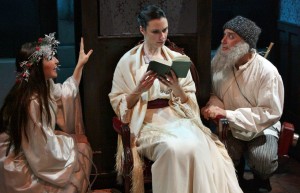 Tennessee Williams, Edward Albee, Ingmar Bergman, and Strindberg’s contemporary Henrik Ibsen all cite him as an important influence on their work. But no playwright was more effected than Eugene O’Neill, who claimed that “Strindberg was the precursor of all modernity in our present theatre. He still remains among the most modern of moderns, the greatest interpreter in the theatre of the characteristic spiritual conflicts which constitute the drama’”the blood’”of our lives today.”
Tennessee Williams, Edward Albee, Ingmar Bergman, and Strindberg’s contemporary Henrik Ibsen all cite him as an important influence on their work. But no playwright was more effected than Eugene O’Neill, who claimed that “Strindberg was the precursor of all modernity in our present theatre. He still remains among the most modern of moderns, the greatest interpreter in the theatre of the characteristic spiritual conflicts which constitute the drama’”the blood’”of our lives today.”
photos by Annie Paladino, Laura Mason, and Rob Melrose
Strindberg Cycle: The Chamber Plays in Rep
The Ghost Sonata, The Pelican, The Black Glove, Storm, and Burned House
The Cutting Ball Theater in residence at EXIT
scheduled to end on Sunday, November 18, 2012
for tickets call 415-525-1205 or http://www.cuttingball.com
